
The GameCube is a home video game console developed and marketed by Nintendo. It was released in Japan on September 14, 2001, in North America on November 18, 2001, in Europe on May 3, 2002, and in Australia on May 17, 2002. It is the successor to the Nintendo 64 (N64) and the predecessor to the Wii. As a sixth-generation console, the GameCube primarily competed with the PlayStation 2 and the original Xbox.
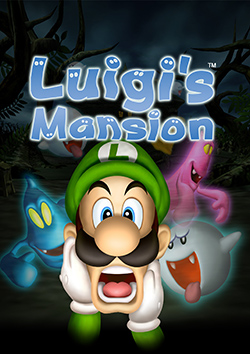
Luigi's Mansion is a 2001 action-adventure game developed and published by Nintendo. The game was a launch title for the GameCube and was the first game in the Mario franchise to be released for the console; it was released in Japan on September 14, 2001, in North America on November 18, 2001, in Europe on May 3, 2002, and in Australia on May 17, 2002. It is the third video game in which Luigi is the main character instead of Mario, after Mario Is Missing! and Luigi's Hammer Toss. Players control him as he explores a haunted mansion, searches for Mario and deals with ghosts by capturing them through a vacuum cleaner supplied by Professor E. Gadd.

Princess Peach is a character in Nintendo's Mario franchise. She was created by Shigeru Miyamoto and introduced in the 1985 original Super Mario Bros. game as Princess Toadstool. She is the princess regnant and head of state of the Mushroom Kingdom, where she resides in her castle along with Toads. Since her debut, she has appeared in the majority of Mario video games as the main female character and the romantic interest of Mario. She has been voiced by Samantha Kelly since 2007.

Super Mario 64 is a 1996 platform game developed and published by Nintendo for the Nintendo 64. It was released in Japan and North America in 1996 and PAL regions in 1997. It is the first Super Mario game to feature 3D gameplay, combining traditional Super Mario gameplay, visual style, and characters in a large open world. In the game, Bowser, the primary antagonist of the Super Mario franchise, invades Princess Peach's castle and hides the castle's sources of protection, the Power Stars, in many different worlds inside magical paintings. As Mario, the player collects Power Stars to unlock enough of Princess Peach's castle to get to Bowser and rescue Princess Peach.
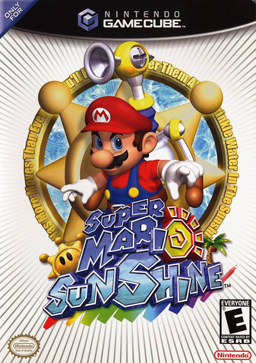
Super Mario Sunshine is a 2002 platform game developed and published by Nintendo for the GameCube. It is the second 3D game in the Super Mario series, following Super Mario 64 (1996). The game was directed by Yoshiaki Koizumi and Kenta Usui, produced by series creators Shigeru Miyamoto and Takashi Tezuka, written by Makoto Wada, and scored by Koji Kondo and Shinobu Tanaka.

Paper Mario: The Thousand-Year Door is a 2004 role-playing game developed by Intelligent Systems and published by Nintendo for the GameCube. The Thousand-Year Door is the second game in the Paper Mario series following Paper Mario, and is part of the larger Mario franchise. In the game, when Mario and Princess Peach get involved in the search for a mystic treasure that holds great fortune, Peach is kidnapped by an alien group called the X-Nauts; Mario sets out to find the treasure and save the princess.

Donkey Kong Jungle Beat is a 2004 platform and score-attack game developed and published by Nintendo for the GameCube. It follows the gorilla Donkey Kong as he sets out to defeat a series of evil kings to conquer the jungle. Jungle Beat is designed for use with the DK Bongos, a bongo drum-style GameCube controller created for the Donkey Konga (2003) rhythm game. The player controls Donkey Kong through various side-scrolling levels as he collects bananas, swings on vines, chains combos, rides animals, and defeats enemies and bosses.

Super Mario Galaxy is a 2007 platform game developed and published by Nintendo for the Wii. It is the third 3D game in the Super Mario series. As Mario, the player embarks on a quest to rescue Princess Peach, save the universe from Bowser, and collect 120 Power Stars, after which the player can play the game as Luigi for a more difficult experience. The levels consist of galaxies filled with minor planets and worlds, with different variations of gravity, the central element of gameplay. The player character is controlled using the Wii Remote and Nunchuk and completes missions, fights bosses, and reaches certain areas to collect Power Stars. Certain levels use the motion-based Wii Remote functions.

Super Mario is a platform game series created by Nintendo starring their mascot, Mario. It is the central series of the greater Mario franchise. At least one Super Mario game has been released for every major Nintendo video game console. However, there have also been a number of Super Mario video games released on non-Nintendo gaming platforms. There are more than 20 games in the series.
Super Monkey Ball is a series of arcade platform video games initially developed by Amusement Vision and published by Sega. The series debuted in 2001 with the arcade game Monkey Ball, which was ported to GameCube as Super Monkey Ball later that year. Several sequels and ports have been released.

The GameCube controller is the standard game controller for the GameCube home video game console, manufactured by Nintendo and launched in 2001. As the successor to the Nintendo 64 controller, it is the progression of Nintendo's controller design in numerous ways. The contentious M-shaped design of its predecessor was replaced with a more conventional handlebar style controller shape; a second analog stick was added, replacing the C buttons with a C stick and the X and Y face buttons, last seen on the Super Nintendo controller, were reintroduced; the shoulder buttons were changed to hybrid analog triggers. A wireless variant of the GameCube controller known as the WaveBird was released in 2002.

The Japanese multinational consumer electronics company Nintendo has developed seven home video game consoles and multiple portable consoles for use with external media, as well as dedicated consoles and other hardware for their consoles. As of September 30, 2021, in addition to Nintendo Switch, Nintendo has sold over 863.07 million hardware units.

Mario is a Japanese multimedia franchise created by Japanese game designer Shigeru Miyamoto for video game company Nintendo, which produces and publishes its installments. Starring the titular Italian plumber Mario, it is primarily a video game franchise but has extended to other forms of media, including television series, comic books, a 1993 feature film, a 2023 animated film, and theme park attractions. The series' first installment was 1983's Mario Bros., although Mario made his first appearance in 1981's arcade game Donkey Kong and had already been featured in several games of the Donkey Kong and Game & Watch series. The Mario games have been developed by a wide variety of developers, including Nintendo, Hudson Soft, and AlphaDream. Mario games have been released almost exclusively for Nintendo's various video game consoles and handhelds, from the third generation onward.

Super Mario All-Stars is a 1993 compilation of platform games for the Super Nintendo Entertainment System (SNES). It contains remakes of Nintendo's four Super Mario games released for the Nintendo Entertainment System (NES) and the Famicom Disk System: Super Mario Bros. (1985), Super Mario Bros.: The Lost Levels (1986), Super Mario Bros. 2 (1988), and Super Mario Bros. 3 (1988). As in the original games, players control the Italian plumber Mario and his brother Luigi through themed worlds, collecting power-ups, avoiding obstacles, and finding secrets. The remakes feature updated graphics—including the addition of parallax scrolling—and music, modified game physics, a save feature, and bug fixes.

Super Mario 3D World is a 2013 platform game developed and published by Nintendo for the Wii U. It is the sixth original 3D platform game in the Super Mario series and the sequel to Super Mario 3D Land (2011) for the Nintendo 3DS.
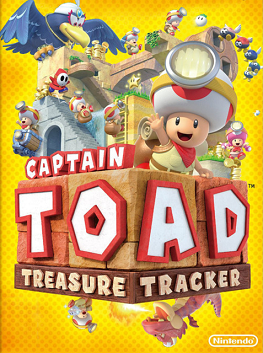
Captain Toad: Treasure Tracker is a 2014 action puzzle video game developed and published by Nintendo for the Wii U. The game was re-released for the Nintendo Switch and Nintendo 3DS in 2018 with additional content. It is a spin-off of the Super Mario series and a part of the larger Mario franchise. The game stars Captain Toad and Toadette as they complete levels, defeat enemies and save each other from the antagonist Wingo. Each level is contained within a miniature diorama-like environment that requires puzzle-solving and platforming challenges to complete. The player also uses the Wii U GamePad to rotate the camera and reveal new information and interact with the environment.
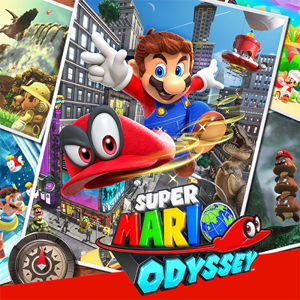
Super Mario Odyssey is a 2017 platform game developed and published by Nintendo for the Nintendo Switch. An entry in the Super Mario series, it follows Mario and his new ally Cappy—a sentient hat that allows Mario to control other characters and objects—as they journey across various kingdoms to save Princess Peach from Mario's nemesis Bowser's plans of forced marriage. In contrast to the linear gameplay of prior entries, the game returns to the primarily open-ended, 3D platform gameplay featured in Super Mario 64 and Super Mario Sunshine.
Paper Mario is a video game series and part of the Mario franchise, developed by Intelligent Systems and produced by Nintendo. It combines elements from the role-playing, action-adventure, and puzzle genres. Players control a paper cutout version of Mario, usually with allies, on a quest to defeat the antagonist, primarily Bowser. The series consists of six games and one spin-off; the first, Paper Mario (2000), was released for the Nintendo 64, and the most recent, Paper Mario: The Origami King (2020), for the Nintendo Switch.
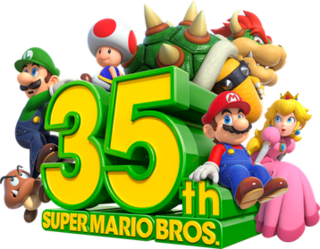
The Super Mario Bros. 35th Anniversary was a celebration of the Super Mario video game series created by Shigeru Miyamoto. The series began with the release of Super Mario Bros. on September 13, 1985, and has since spanned over twenty games appearing on every major Nintendo video game console. Through a series of leaks initially reported by Video Games Chronicle in March 2020, plans revealed that Nintendo originally planned to celebrate the anniversary earlier in 2020; however, due to the COVID-19 pandemic, the anniversary was postponed to September that same year. The anniversary was announced in a Nintendo Direct on September 3, 2020, and ran until March 31, 2021.

Bowser's Fury is a 2021 platform game developed and published by Nintendo for the Nintendo Switch. It is an original 3D platform entry in the Super Mario series and a spin-off title that derives mechanically from Super Mario 3D World (2013). The game's story involves Mario reluctantly helping Bowser Jr. on a series of cat-themed islands surrounding Lake Lapcat, which are being terrorized by an enhanced form of his enemy Bowser called Fury Bowser, having been transformed by mysterious black sludge that has also enveloped the various island regions.

















